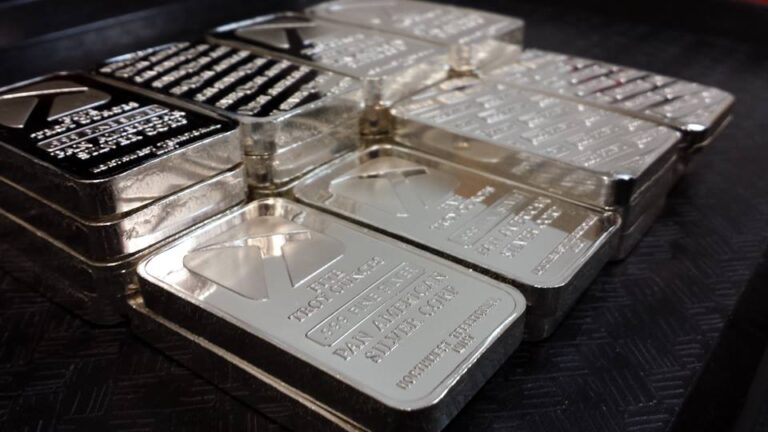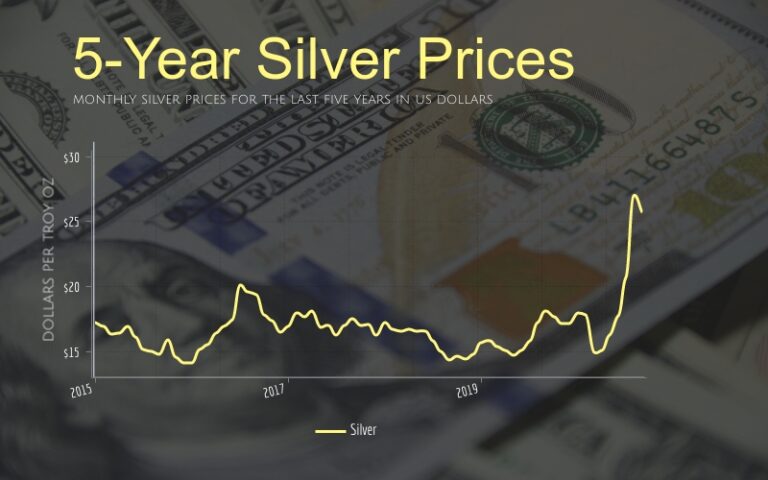Real-Time Silver Price Per Ounce

Silver has long been considered one of the most precious metals, often compared to a shiny river of liquid light. Its value is determined by a variety of factors that make its price fluctuations difficult to predict.
This article will explore how silver prices are determined in real-time and discuss the significance of silver as an investment option today. It will also provide strategies for maximizing returns on silver investments.
How Is the Price of Silver Determined?
The determination of the value of silver is a complex process that requires careful consideration.
Various factors influence its price, including supply and demand, industrial demand, market speculation, inflation, currency exchange rates, and geopolitical developments.
Supply and demand are the main determinants of silver’s price.
When there is more demand than supply for silver on the market, prices tend to rise; on the other hand, when there is an oversupply of silver relative to current demand, prices tend to decrease.
Industrial demand can also affect pricing in a major way as industrial products use large amounts of silver in their production process which increases or decreases depending on economic conditions.
Market speculation also has a significant impact on pricing as traders buy and sell positions based on perceived future values.
Inflation can increase or decrease the value of silver as well due to its notoriety as a safe-haven asset in times of financial instability.
Lastly, currency exchange rates play an important role since this commodity is traded across countries with different currencies which affects its global valuation.
All these factors must be taken into account when looking at real-time silver prices per ounce.
Factors That Affect Silver Price Fluctuations
Fluctuations in the value of silver can be likened to a roller coaster ride, with various forces at work influencing its movement. Among the many factors that affect silver prices are:
- Market conditions – Supply and demand of silver, changes in economic indicators, and geopolitical events all play a role in determining the price of silver.
- Investment activity – Silver is viewed as an investment option by individuals and institutions alike; therefore, large-scale investments can influence market prices.
- Global currency exchange rates – Silver is priced and traded primarily against other major world currencies, so fluctuations in currency exchange rates can cause volatility in the price of silver.
These factors contribute to real-time price changes in the global spot markets for silver which are tracked by futures contracts and other financial instruments designed to track short-term movements. The overall trend is determined by longer term supply/demand dynamics, consumer sentiment towards precious metals, or macroeconomic developments. Consequently, it is important to stay informed on these topics when considering investing or trading in silver markets.
Factors That Contribute to the Value of Silver
Changes in supply and demand dynamics, consumer sentiment towards precious metals, and macroeconomic developments all contribute to the value of silver. The first factor is changes in supply and demand dynamics. Silver’s value is directly related to its availability; when there is a shortage of the metal, prices tend to increase as buyers compete with each other for limited supplies. Conversely, when there is an overabundance of silver available on the market, prices will decrease due to lower competition among buyers.
The second factor influencing silver prices are consumer sentiment towards precious metals. When investors feel uncertain about economic conditions or stock markets, they often turn their attention to commodities such as gold and silver as safe havens investments that can provide protection from volatility. This increased demand for these metals drives up their price value as well. Finally, macroeconomic indicators like interest rates can also have an effect on the market price of silver; when interest rates rise, it becomes more attractive for investors to purchase bonds than precious metals which decreases demand for these commodities and lowers their value accordingly.
| Factor | Description | Effect on Value |
|---|---|---|
| Supply & Demand Dynamics | Availability of Silver in Market | Increase/Decrease Prices Depending on Surplus or Shortage |
| Consumer Sentiment | Investor Interest in Precious Metals | Increased Demand Drives Up Price Value |
| Macroeconomic Indicators | Interest Rates | Higher Interest Rates Attract Investors Away from Metals Resulting in Lower Prices |
The Significance of Silver Price in Today’s Market
Today, silver is a valuable asset that investors use to diversify their portfolios and hedge against economic uncertainty. The real-time price of silver per ounce contains information about its demand and supply in the market, which can be used by investors to gauge trends in the market.
Silver prices are affected by various factors such as investor sentiment, political events, currency fluctuations and other macroeconomic conditions. For example, if there is an increase in inflation rates globally then it might lead to higher demand for silver as a store of value. In addition, if geopolitical tensions rise then the prices of precious metals like silver usually go up due to safe haven buying from investors.
Silver prices also reflect its industrial usage since it is widely used in many industries including electronics manufacturing and jewelry making. Any changes in production levels or new uses being discovered can influence the price of silver significantly.
Therefore, understanding the current price of silver is essential for both investors and industry participants alike as it helps them make informed decisions regarding investments or production plans respectively.
Overall, with its dual role in portfolio diversification and industrial applications, the significance of real-time silver price per ounce in today’s market cannot be overstated.
Strategies for Maximizing Silver Investments
Investors can maximize their returns from silver investments by taking into account the various factors that affect its price and leveraging strategies to capitalize on them.
Silver prices are largely affected by demand, supply, investment sentiment, and geopolitical factors such as currency exchange rates, the health of economies, and even natural disasters or political events.
Investors should analyze these influences to understand how they might impact silver prices in both the short-term and long-term.
In addition to analyzing these external factors, investors should also consider several different investing strategies when looking to maximize their silver investments.
These include buying physical precious metals like coins or bars; purchasing certificates representing ownership of a certain amount of silver; trading futures contracts; investing in exchange-traded funds (ETFs) that hold physical metals; and investing in mining stocks that focus on producing silver.
Each approach has its own associated risks and rewards which must be taken into consideration before making an investment decision.
Frequently Asked Questions
How can I track the real-time price of silver?
The price of silver fluctuates constantly, making it difficult to accurately track its real-time value. However, there are a number of resources available that can help investors stay up to date with the latest silver prices.
According to recent data, the average global spot price of silver is currently around $17 per troy ounce and has seen an overall increase in value since July 2020. Many websites offer live charts and graphs displaying the current prices for silver as well as historical trends and analyses.
Additionally, there are numerous mobile apps available which provide quick access to past and present pricing information so that investors can make informed decisions quickly and easily.
What are the current trends in silver prices?
Silver prices have seen a steady increase in recent years, with the metal hitting its highest point since 2015 in July 2019.
Analysts attribute this to an increased demand for silver from industrial sectors such as electronics, automotive and solar energy. This is due to silver’s properties of being an excellent conductor of heat and electricity, as well as its low cost compared to other materials.
Silver has also seen increasing investment interest from individuals due to its value stability and liquidity relative to gold. Furthermore, geopolitical tensions across the world are also driving up demand for silver as investors seek safe-haven investments.
Are there any risks associated with investing in silver?
Investing in silver can be a risky proposition due to the volatility of the market. The price of silver is affected by both macroeconomic and geopolitical factors, meaning that it can fluctuate drastically from day to day or even within a few hours.
In addition, silver prices are heavily influenced by supply and demand forces; if supplies become too tight or demand for silver increases significantly, then prices can rise quickly. If the price falls suddenly, investors could face losses on their investments.
Thus, investors must carefully evaluate the potential risks associated with investing in silver before committing any funds to this asset class.
What is the best way to buy silver?
When it comes to buying silver, the best way is to purchase physical silver bullion. This includes coins, rounds, and bars of various sizes.
Silver bullion is typically sold in increments of one ounce or higher and come with the lowest premiums over spot price. For example, a typical 1-ounce American Silver Eagle coin will carry a premium as low as 5% over the current spot price of silver per ounce.
Additionally, owning physical silver offers investors protection against market volatility and currency devaluation since it has tangible value.
What is the difference between silver and gold prices?
Gold and silver are two of the most popular precious metals, often used as investments or for creating jewelry.
Gold is generally considered a more valuable metal than silver due to its higher price per ounce and greater rarity.
The differences between gold and silver prices depend on a variety of factors, including current supply and demand, market speculation, inflationary trends, political stability in mining countries, as well as the strength of currencies.
Additionally, gold tends to be less volatile than silver since it is seen as a safe-haven asset during economic downturns.
Conclusion
Silver is an important commodity in the modern world. Its price fluctuates due to a variety of factors, including market demand, currency exchange rates, inflation, and geopolitical developments. As such, investors must take a strategic approach when investing in silver to maximize their potential gains.
Silver is like a chameleon that can quickly change its value depending on the prevailing economic conditions. Therefore, it is critical for investors to stay informed about current silver prices per ounce and make wise decisions based on accurate data points.
With careful analysis and strategic planning, investors can maximize their silver investments and potentially benefit from profitable returns in real-time.






